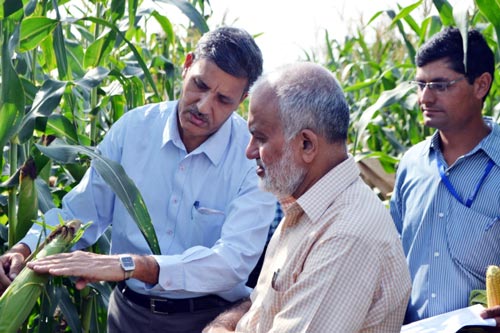
By O.P. Yadav/Indian Council of Agricultural Research
More than 120 researchers, policymakers and other stakeholders participated in a commercial hybrid demonstration and maize brainstorming sessions organized by the Directorate of Maize Research, Indian Council of Agricultural Research (ICAR). The National Demonstration of Maize Commercial Hybrids and sessions were held 21-22 September in New Delhi.
The event demonstrated 106 maize hybrids, including leading hybrids from the public and private sectors. Visitors included S. Ayyappan, ICAR Director General; Ashish Bahuguna, secretary of the Department of Agriculture and Cooperation for the Government of India; H.S. Gupta, director of the Indian Agricultural Research Institute; B.S. Dhillon, vice chancellor of Punjab Agricultural University; J.S. Sandhu, commissioner of agriculture; R.P. Dua, assistant director general of food and fodder crops; J.S. Chauhan, assistant director general of seeds; S. Mauria, assistant director general of intellectual property & technology management; and more than 100 researchers from the national agricultural research system. P.H. Zaidi, B.S. Vivek and A.R. Sadananda from the Global Maize Program based in Hyderabad represented CIMMYT.
While visiting the demonstration, Ayyappan said he was impressed with the national maize program’s efforts to develop diverse maize hybrids that meet farmers’ needs in India’s different agro-ecological regions. He lauded the development and fine-tuning of maize production technology that has resulted in many improvements in the last decade. Bahuguna said the initiative was a unique showcase of hybrid technology that can improve farmers’ income. Providing farmers with a wide variety of hybrids can help achieve crop diversification in different regions, he noted. Bahuguna was also interested in new hybrids likely to be available to farmers in the near future.
Gupta emphasized the opportunities that exist to replace low-yielding, traditional maize varieties with hybrids, while Dhillon highlighted the importance of an effective seed production program to fully harness the hybrids’ benefits. Other topics included the objective of the demonstration and how to expand the scale of hybrid initiatives. Chauhan said the demonstration exhibited the strength of public research and development. Three brainstorming sessions – “Public-Private Partnerships,” “Trait Prioritization in Breeding” and “Improving Drought Tolerance” – followed the demonstration. They were led by S.K. Datta, deputy assistant director general for crop sciences, B.S. Dhillon and Sain Das, while Vivek and Zaidi contributed as panelists. More than 100 personnel from the public and private sectors participated. Datta underlined the role of both sectors and called upon scientists to identify areas where they can work together.
 Capacity development
Capacity development